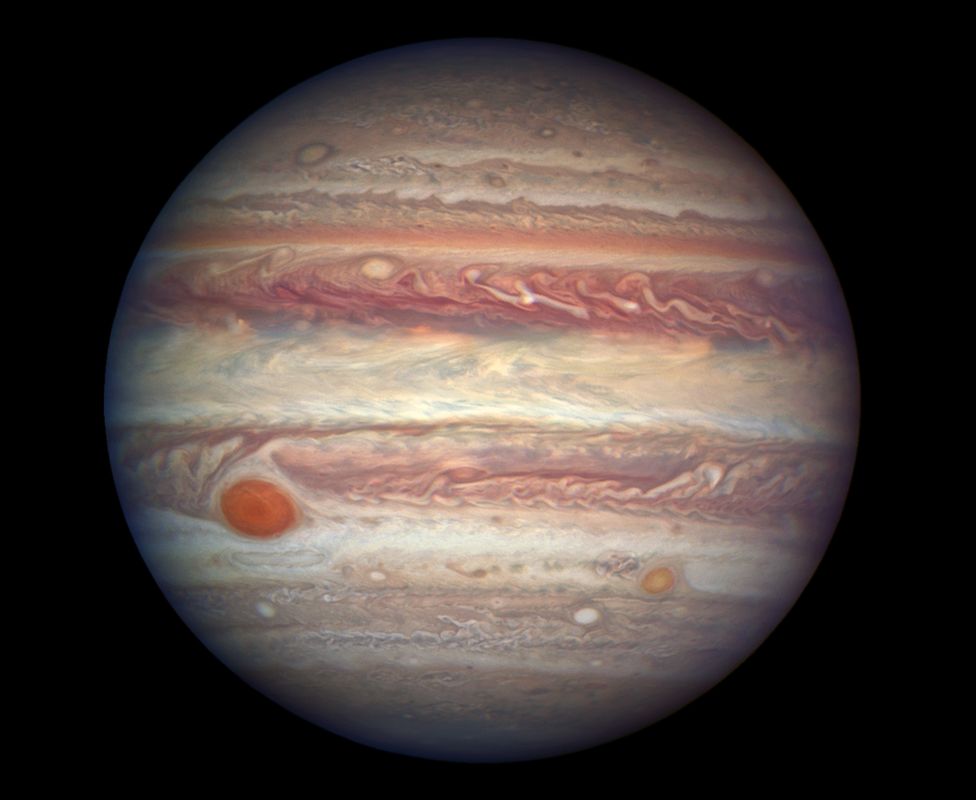Science: Scientists obtain ‘lucky’ image of Jupiter – The Heat on Jupiter – My Comments
(:E-:N-:R-AZ:C-30:V)
[Many years ago in my wonky writings, I made the point that Jupiter and even Saturn, which are far away from the Sun, mysteriously produce much more heat than they receive from the sun. They themselves are a source of heat. In this photo below you'll see a new method used by scientists to get an image of the planet and their focus is the heat in the clouds. Even more mysterious is the Great Red spot, which is an enormous storm on the planet. All these things are mysteries. I gave my own thoughts as to what was the cause of this. The mystery of Jupiter thus remains … even in 2020. What I do like is the way science is advancing and the new methods, especially with telescopes on earth, are amazing. The man's science, as always, is incredible! Jan]
- 8 May 2020
- Share this with Facebook
- Share this with Messenger
- Share this with Twitter
- Share this with Email
- Share
 Image copyrightGEMINI OBSERVATORY/M.H.WONG ET ALImage captionIt took hundreds of exposures to build this sharp image mosaic of Jupiter in the infrared
Image copyrightGEMINI OBSERVATORY/M.H.WONG ET ALImage captionIt took hundreds of exposures to build this sharp image mosaic of Jupiter in the infrared![]()
Astronomers have produced a remarkable new image of Jupiter, tracing the glowing regions of warmth that lurk beneath the gas giant’s cloud tops.
The picture was captured in infrared by the Gemini North Telescope in Hawaii, and is one of the sharpest observations of the planet ever made from the ground.
To achieve the resolution, scientists used a technique called "lucky imaging" which scrubs out the blurring effect of looking through Earth’s turbulent atmosphere.
This method involves acquiring multiple exposures of the target and only keeping those segments of an image where that turbulence is at a minimum.
When all the "lucky shots" are put together in a mosaic, a clarity emerges that’s beyond just the single exposure.
Infrared is a longer wavelength than the more familiar visible light detected by the likes of the Hubble telescope. It is used to see past the haze and thin clouds at the top of Jupiter’s atmosphere, to give scientists the opportunity to probe deeper into the planet’s internal workings.
Researchers want to understand better what makes and sustains the gas giant’s weather systems, and in particular the great storms that can rage for decades and even centuries.
The study that produced this infrared image was led from the University of California at Berkeley. It was part of a joint programme of observations that involved Hubble and the Juno spacecraft that’s currently orbiting the fifth planet from the Sun.
![]()
Fast facts about Jupiter
- Jupiter is 11 times wider than Earth and 300 times more massive
- It takes 12 Earth years to orbit the Sun; a ‘day’ is 10 hours long
- In composition it resembles a star; it’s mostly hydrogen and helium
- Under pressure, the hydrogen assumes a state similar to a metal
- This ‘metallic hydrogen’ could be the source of the magnetic field
- Most of the visible cloudtops contain ammonia and hydrogen sulphide
- Jupiter’s low-latitude ‘bands’ play host to very strong east-west winds
- The Great Red Spot is a giant storm vortex wider than Planet Earth
 Image copyrightNASA/ESA/A.SIMONImage captionJupiter as seen in visible wavelengths of light by Hubble
Image copyrightNASA/ESA/A.SIMONImage captionJupiter as seen in visible wavelengths of light by Hubble![]()
Source: https://www.bbc.com/news/science-environment-52587488
Video: Alex Linder & Jan: Video: Beyond Person and White: A breakdown of different race groups in SA
Alex Linder and Jan discuss race relations in South Africa as they are now. What are the various races of people in South Africa and how do they view each other and of special importance, how do they view People?
Jan‘s Videos about Rhodesia
Here is a list of most (but not all) of my videos about Rhodesia...
Audio: Christa Schroeder: The Memoirs of Adolf Hitlers Secretary
This lady worked for Hitler for 12 years. She was very interested in Hitler as a person and even in his past. She was in his inner circle for many years and saw many things. She never married and she survived WW2.

